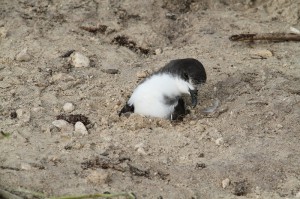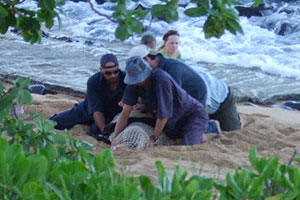
The US Fish and Wildlife Service (FWS) has provided details of the severe impact to wildlife of the Japanese tsunami, as it rolled over the islands comprising Midway Atoll on Thursday March 10th.
A news release issued by FWS states: “Fortunately, Midway residents received approximately 4 hours of advanced warning and successfully implemented its tsunami emergency plan. All essential infrastructure and equipment were secured and all staff, contractors, and visitors evacuated to the third floor of the Charlie Hotel. Fortunately, no one was injured and no major damage occurred to the island’s infrastructure. Debris washed onto the airfield which caused its temporary closure for less than 24 hours.

 The National Oceanic Atmospheric Administration (NOAA), National Marine Fisheries Service (NMFS), Pacific Islands Regional Office (PIRO) has published the
The National Oceanic Atmospheric Administration (NOAA), National Marine Fisheries Service (NMFS), Pacific Islands Regional Office (PIRO) has published the  […] After swimming at the northern end of the beach, I was heading back when I spotted four men and two women mugging an endangered Hawaiian monk seal that I’d previously seen sleeping peacefully among the rocks. The seal’s face was covered with a net, but its eyes met mine and they conveyed terror, which left me with a sickeningly disturbed feeling that still lingers.
[…] After swimming at the northern end of the beach, I was heading back when I spotted four men and two women mugging an endangered Hawaiian monk seal that I’d previously seen sleeping peacefully among the rocks. The seal’s face was covered with a net, but its eyes met mine and they conveyed terror, which left me with a sickeningly disturbed feeling that still lingers. Medical waste and other trash continued to soil Leeward Coast beaches yesterday, washing ashore in spots farther down the shore from where the debris was initially found. […]
Medical waste and other trash continued to soil Leeward Coast beaches yesterday, washing ashore in spots farther down the shore from where the debris was initially found. […] On the beaches of the Hawaiian islands, monk seals are dying from a pathogen in cat feces that is carried to the ocean in polluted runoff and sewage. Experts worry that the disease, toxoplasmosis, will derail efforts to restore the endangered species. With only about 1,100 Hawaiian monk seals left in the wild, the deaths are “very concerning and put toxo as one of our primary concerns” for the species, says NOAA scientist Charles Littnan. Throughout most of Hawai`i, surface water quality ranges from “slightly impaired to severely impaired,” according to a state assessment. In particular, runoff from densely populated watersheds on Maui and O`ahu likely contains pathogens that infect the seals. […]
On the beaches of the Hawaiian islands, monk seals are dying from a pathogen in cat feces that is carried to the ocean in polluted runoff and sewage. Experts worry that the disease, toxoplasmosis, will derail efforts to restore the endangered species. With only about 1,100 Hawaiian monk seals left in the wild, the deaths are “very concerning and put toxo as one of our primary concerns” for the species, says NOAA scientist Charles Littnan. Throughout most of Hawai`i, surface water quality ranges from “slightly impaired to severely impaired,” according to a state assessment. In particular, runoff from densely populated watersheds on Maui and O`ahu likely contains pathogens that infect the seals. […]